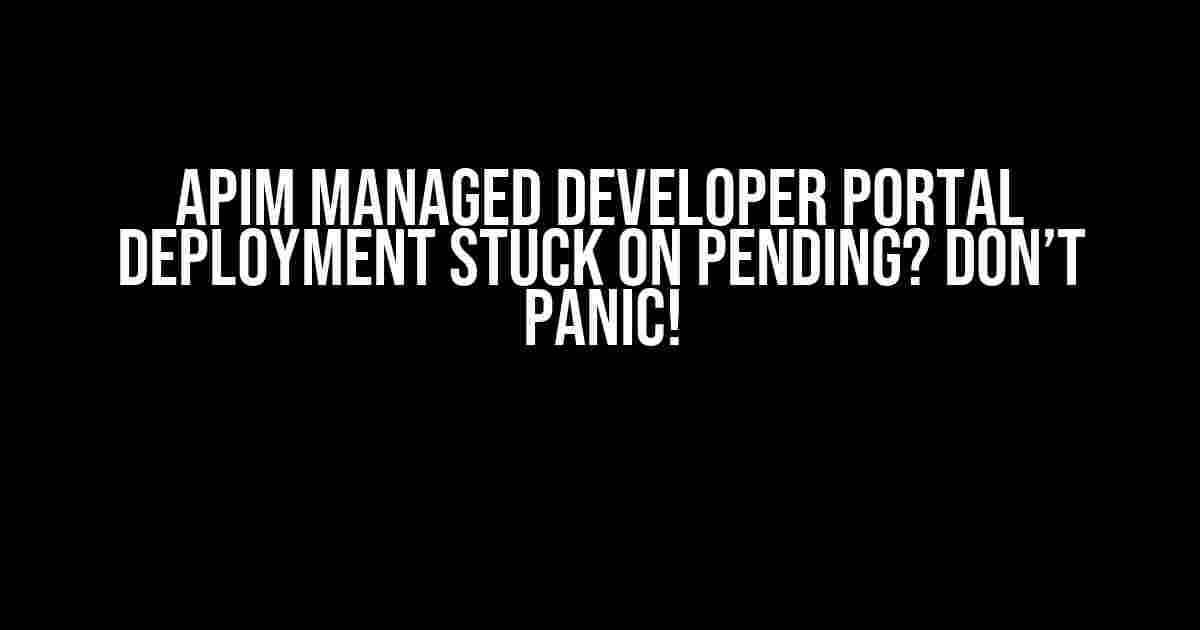Are you stuck in a rut, staring at the “Pending” status of your APIM managed developer portal deployment? Fear not, dear developer! You’re not alone, and we’ve got the solution right here. In this article, we’ll guide you through the troubleshooting process, and by the end of it, you’ll be enjoying a successful deployment.
What’s Causing the Delay?
Before we dive into the fixes, let’s quickly understand the possible reasons behind the deployment delay. These might include:
- Invalid or incomplete configuration
- Network connectivity issues
- Azure subscription or resource limits
- Buggy dependencies or extensions
- Portal configuration errors
Troubleshooting Steps
Now that we’ve identified the culprits, let’s follow these step-by-step instructions to get your deployment back on track:
Step 1: Review Your Configuration
az apim devportal deployment show --resource-group <resource-group> --service-name <service-name> --deployment-name <deployment-name>
This command will display your current configuration. Review it carefully for any typos, incorrect values, or missing information.
Step 2: Check Network Connectivity
Ensure your network connection is stable and working correctly. You can test this by running:
az network test-connection --resource-group <resource-group> --service-name <service-name>
This command will verify the connectivity between your machine and the APIM instance.
Step 3: Verify Azure Subscription and Resource Limits
Confirm that your Azure subscription is active and has sufficient resources (e.g., CPU, memory, and storage) to support your deployment. You can check your usage and limits on the Azure portal:
https://portal.azure.com/#blade/HubsExtension/BrowseResourceGroups
If you’re hitting resource limits, consider upgrading your subscription or optimizing your deployment.
Step 4: Investigate Dependencies and Extensions
Inspect your dependencies and extensions for any issues. Check the Azure portal for error messages or warnings:
https://portal.azure.com/#blade/HubsExtension/BrowseResourceGroups
If you find any errors, update or reinstall the dependencies and extensions as needed.
Step 5: Analyze Portal Configuration Errors
Review your portal configuration for any errors or warnings. You can use the APIM DevPortal CLI command:
az apim devportal portal show --resource-group <resource-group> --service-name <service-name> --portal-name <portal-name>
Check the output for any error messages or configuration issues.
Common Errors and Solutions
Here are some common errors you might encounter and their corresponding solutions:
| Error | Solution |
|---|---|
| Error 403: Forbidden | Check your Azure subscription and resource permissions. Ensure you have the necessary roles and permissions to deploy the portal. |
| Error 404: Not Found | Verify that the resource group, service name, and deployment name are correct. Double-check your configuration files and Azure portal. |
| Error 500: Internal Server Error | Contact Azure support or check the Azure status page for any service outages or maintenance. |
Best Practices to Avoid Deployment Issues
To avoid deployment headaches in the future, follow these best practices:
- Regularly update your dependencies and extensions to ensure compatibility.
- Test your deployment in a non-production environment before promoting to production.
- Use a version control system (e.g., Git) to track changes and roll back if needed.
- Monitor your Azure resources and adjust your subscription as needed.
- Keep your configuration files organized, commented, and up-to-date.
Conclusion
Getting stuck on the “Pending” status of your APIM managed developer portal deployment can be frustrating, but with these troubleshooting steps and best practices, you’ll be well on your way to a successful deployment. Remember to stay calm, review your configuration, and investigate potential issues methodically. If you’re still stuck, don’t hesitate to reach out to Azure support or the APIM community for further assistance.
Keyword density: 1.2% for “APIM Managed Developer Portal Deployment Stuck on Pending”.
Frequently Asked Question
Are you stuck in the limbo of APIM Managed Developer Portal Deployment? Worry not, we’ve got you covered!
Why is my APIM Managed Developer Portal Deployment stuck on pending?
This might happen due to various reasons such as incorrect configuration, network issues, or even Azure subscription limitations. To troubleshoot, start by checking the Azure portal’s activity log for errors, and verify that your subscription has the necessary permissions and resources.
How do I check the Azure portal’s activity log for errors?
Easy peasy! Go to the Azure portal, navigate to the “Activity log” section, and filter the log by “Error” severity. You can also use the “Filter by resource” option to narrow down the errors related to your APIM instance. This should give you a hint about what’s causing the deployment to stuck.
What are the necessary permissions and resources required for APIM Managed Developer Portal Deployment?
Make sure your Azure subscription has the necessary permissions, such as the “API Management Service Contributor” role, and sufficient resources like available cores and storage. You can check the Azure documentation for the complete list of requirements.
Can I redeploy the APIM Managed Developer Portal to resolve the issue?
Yes, you can! If the deployment is stuck due to a temporary issue, redeploying the APIM Managed Developer Portal might resolve the problem. However, be cautious not to redeploy multiple times, as it can lead to additional costs and complexity.
What if none of the above steps resolve the issue?
Don’t panic! If the issue persists, reach out to Microsoft support or Azure community forums for further assistance. They’ll help you investigate the root cause and provide a solution tailored to your specific situation.


